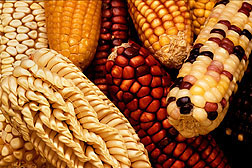This page has been archived and is being provided for reference purposes only. The page is no longer being updated, and therefore, links on the page may be invalid.
Corn Breeding Enters a New EraBy Ben HardinSeptember 9, 1997 In the past half century, corn yields have more than tripled, mostly because of plant breeding. But that’s only the beginning of advances for the crop, thanks to a new cooperative project begun last year by public and private breeders. Until now, yields of hybrids have increased steadily by breeding the best inbred lines together. But that’s resulted in a narrowed genetic base. A broader genetic base would help plant breeders develop hybrids less likely to succumb to insect and disease epidemics. A company’s efforts to breed a new line adapted to U.S. growing conditions and with exotic genes have normally taken up to 20 years--with no guaranteed success. Breeding goals may be reached quicker as researchers in 20 companies, 16 universities and six locations of USDA’s Agricultural Research Service pool resources in a project called GEM, short for Germplasm Enhancement of Maize. Their goal: to search out commercially interesting genes from exotic and U.S. corn varieties. Already identified are promising breeding lines that produce grain with 16 percent protein and 6 percent oil. Today’s Corn Belt hybrids contain about 10 percent protein and 4 percent oil. GEM is a follow-up to ARS’ Latin American Maize Project, or LAMP, financed by Pioneer Hi-Bred International of Des Moines, Iowa. LAMP evaluated 12,000 Latin American and U.S. corn varieties for their breeding value and identified the 268 most promising. The cooperative effort should foster development of specialty corns, to increase the U.S. share of agricultural export markets and provide more predictable quality characteristics at home and abroad. A field day to display GEM progress will be held Sept. 16 near Ames, Iowa. Another was held yesterday near Madison, Wisc. GEM is discussed in an article in the September issue of Agricultural Research magazine. The information can also be viewed at the World Wide Web at: /is/AR/archive/sep97/maize0997.htm Scientific contact: Linda M. Pollak, ARS Corn Insects and Crop Genetics Research, Ames, Iowa, phone (515) 294- 7831, fax (515) 294-8469, lmpollak@iastate.edu. |

